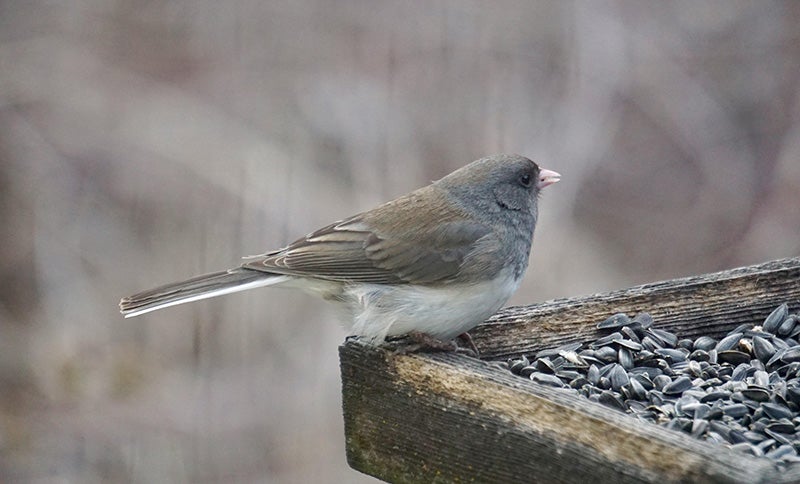Al Batt: Each day is a gift, even as colder weather approaches in the area
Published 9:00 am Saturday, October 21, 2017

- A snowbird takes a break for a snack. Al Batt/Albert Lea Tribune
My neighbor Crandall stops by.
“How are you doing?” I ask.
“Everything is nearly copacetic. I feel so good and so young, I wonder why I’m not still in school. I think my doctor is trying to get me to slow down. That’s why he makes me wait two hours before seeing me. I spend so much time in his waiting room that I catch everything that is going around. It’s like junior high shop class when our teacher told us, ‘If someone loses a finger, everyone loses a finger.’ Speaking of doctors, I had to take Pop to see the eye-ear doctor.“
“I’ve never heard of an eye-ear doctor,” I say. “Why did he need to see that kind of a doctor?”
“Because he keeps hearing one thing and seeing another.”
Naturally
Each day is a gift. The white-throated sparrows sing, even though it’s fall, albeit less sprightly than in the spring. They whistle, “Old Sam Peterson, Peterson, Peterson.”
We stood in the rain. One of the group of birders, with rain dripping down from the brim of his cap, looked at the screen of his cellphone and said, “My weather app says it might rain.”
That’s an app worth having.
Q&A
Helen Knapp of Albert Lea asked if it’s a-OK to feed pumpkin seeds to birds. Pumpkin and other varieties of squash seeds provide a highly nutritious food for our avian amigos. Put the seeds out as scooped from the pumpkin, dried naturally or dried in an oven.
“When do the first monarch butterflies arrive at their winter roost sites in Mexico?” The first monarchs arrive at their winter home in Mexico by Nov. 1. The Purépecha Indians called them harvester butterflies, because they appear when it’s time to harvest the corn. The Mexican holiday Day of the Dead (Dia de los Muertos) occurs when the monarchs appear. According to traditional belief, the monarchs are the souls of ancestors who return to earth for an annual visit.
“Are juncos residents of southern Minnesota all year?” No. They’re summer residents in Minnesota in the coniferous forests of the northeast and north central regions. Dark-eyed juncos are often called “snowbirds” because people believe that their return from their northern breeding grounds foretells the return of cold and snowy weather. Another source of the nickname may be the junco’s white belly and gray back, which has been described as “leaden skies above, snow below.” A New Hampshire study on the foraging habitats of the juncos found that they spent 65 percent of their time on the ground, 20 percent in shrubs and 16 percent in saplings or low trees. They were never observed in the canopy of large trees.
Verna Hoppe writes, “Last Saturday lots of juncos stopped for a short visit, but were gone Sunday morning. Why didn’t they stay a little longer?” They probably headed farther south. Adults, especially females, tend to migrate farther and begin migration earlier. For example, winter junco flocks are 20 percent female in Michigan and 72 percent female in Alabama.
“Is Woody the Woodpecker based on a pileated woodpecker?” Walter Lantz, the creator of Woody Woodpecker, wrote that while he and his wife, Grace, were honeymooning in a California cabin, an acorn woodpecker entertained them. Grace said to Walter, “Why don’t you make him into a character?” Woody the Woodpecker was born.
“How do birds chew food when they don’t have teeth?” By manipulating their food with their tongues, birds are able to crack seeds into manageable pieces with their bills. A bird swallows food and stores it in its crop — a sac at the bottom of the esophagus. It can also soften hard food with mucus. Food goes into the glandular stomach, a tube-like area that produces a large amount of digestive juices. The food then passes through the gizzard, where it’s ground up. Grain-eating birds sometimes swallow small stones, shells and sand to aid in breaking apart hard seeds. These grinding stones in the gizzard wear down eventually and pass through the bird’s system.
A raven ate my
parking ticket
A raven was caught on video plucking and shredding a parking ticket from under the windshield wiper of a car in downtown Yellowknife. It’s unclear if the raven was disputing the ticket or just mischievous. Officials said the ticket still needed to be paid. Ravens hang out in the parking lots of Yellowknife, in Canada’s Northwest Territories, perching on cars and foraging for food.
Thanks for stopping by
“Let us decide on the route that we wish to take to pass our life, and attempt to sow that route with flowers.” — Madame du Chatelet
“The earth is what we all have in common.” — Wendell Berry
Do good.
Al Batt of Hartland is a member of the Albert Lea Audubon Society. Email him at SnoEowl@aol.com.



